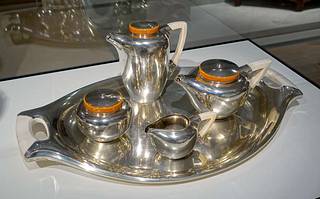
Similar
Coffee and tea service by Henry van de Velde, c. 1903-1904, silver, ivory, bakelite, 2 of 2 - Hessisches Landesmuseum Darmstadt - Darmstadt, Germany - DSC00731
Summary
Exhibit in the Hessisches Landesmuseum Darmstadt - Darmstadt, Germany. As a utilitarian object, this exhibit is NOT subject to copyright laws. Instead it is subject to Industrial Design Rights; see Industrial Design Right for more information. If this object was ever covered by a design patent, that patent has long since expired, and thus this image is in the public domain.
Jugendstil, meaning "Youth Style" in German, was an artistic movement that flourished in Germany and parts of Europe from the mid-1890s to around 1910. It's essentially the German version of the broader Art Nouveau movement. The movement has its roots in Munich, Germany. In 1892, a group of visual artists formed the Munich Secession, breaking away from the conservative styles of the art establishment. Their magazine, Jugend (Youth), founded in 1896, became a major platform for Jugendstil ideas and design. The Munich Secession inspired similar movements in other cities like Vienna and Berlin, each with their own take on Jugendstil. Publications like Simplicissimus and Pan further fueled the movement's reach. The style went through two main phases. The earlier phase, before 1900, was heavily influenced by English Art Nouveau and Japanese art. Think flowing, natural forms and floral motifs. Later, a more abstract style emerged, pioneered by the Belgian-born architect Henry van de Velde working in Vienna.
Tags
Date
Source
Copyright info


















